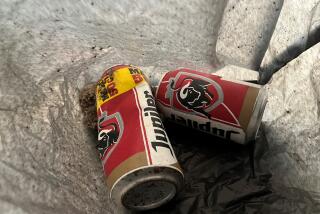Pompidou tries to pick up pieces
- Share via
The Pompidou Center in Paris, pressed to explain the accidental destruction of two borrowed works by Los Angeles artists, has pinpointed the cause of one piece’s ruin: Human error. Not letting glue dry on a Peter Alexander resin work.
The cause of the trouble with the second work, by Craig Kauffman, remains uncertain. But Bruno Racine, the Pompidou’s chairman, said in a prepared statement that he was “personally very sorry” about both accidents. Racine also vowed to “use this experience to learn” and said he would tighten internal standards and seek greater transparency in art-handling practices at the Pompidou and elsewhere.
In addition to compensating the owners of the works for their estimated value -- $28,000 to the Franklin Parrasch Gallery in New York, Alexander’s dealer; and $60,000 to the Los Angeles County Museum of Art, which owned the Kauffman -- the Paris museum is offering to cover the cost if either artist would like to remake his work. Efforts to reach the artists for comment were unsuccessful.
Both pieces were part of “Los Angeles 1955-1985,” a March to July show that attracted about 300,000 visitors. But its opening and close were marred by works falling from the wall. In a press conference Thursday, museum leaders disclosed details from an internal probe.
The untitled Alexander work, a black vertical bar of resin made by the artist in 1971, fell on March 2, the day it was hung.
The museum had contacted the artist only the day before for instruction on how to hang the work, but that exchange, the museum report found, didn’t include any discussion of a small metal ring that installers believed was loose.
A conservator glued the metal ring in place, the report found, which should have been followed by a 24-hour wait. Instead, because of “a misunderstanding between the [conservator] and the person hanging the work,” it was fixed to the wall four or five hours later the same day, said Pompidou communication director Roya Nasser.
The second major accident came July 15, two days before the close of the exhibition, when Kauffman’s 39-year-old acrylic lacquer “Untitled Wall Relief” crashed to the floor. The installation had been supervised by LACMA’s head conservator, John Hirx, and it had been on display for 130 days by the time it fell, its demise witnessed by four visitors and a guard, all of whom said nobody had touched it.
Unable to isolate a cause, the Pompidou’s team offered two possible explanations: that “the hang” was faulty from the start; or that a visitor touched the work and dislodged it enough to cause a fall later on.
“We are fully responsible for works that are on loan to us and in no way do we shirk from that responsibility,” said Racine.
He said the museum will submit its installation procedures to review by an independent organization. He also said the museum would “publish details of any major incidents immediately” and devote a section to the subject in the museum’s annual report. Further, Racine said, the museum’s director, Alfred Pacquement will take the issue to the International Council of Museums “to discuss with our peers how we might all work together for greater transparency.”
In the wake of the Times’ Aug. 3 disclosure of the destroyed works, several private collectors and dealers spoke of their dissatisfaction with the museum’s art-handling and some said it had a reputation for carelessness.
Communications director Nasser took issue with that, pointing to figures from the museum’s internal probe. In lending about 3,000 artworks yearly and borrowing about 2,600, she said, the Pompidou has seen roughly three of its own works damaged elsewhere for every two borrowed works damaged in Paris.
In 2005, she said, the Pompidou had 11 incidents, and paid out an average of $1,424 per artwork.
At the Museum of Contemporary Art in L.A., chief curator Paul Schimmel said the museum has a long history of fruitful cooperation with the Pompidou, both lending and borrowing.
In addition to more than 10 pieces it loaned without incident for the Pompidou show on L.A. art, Schimmel said, MOCA would be sending 10 Rauschenberg combines to Paris next month as part of a traveling exhibition. As is customary, he noted, MOCA would have four staffers on hand to supervise the installation, and has secured insurance to cover the works in Paris.
christopher.reynolds@latimes. com
More to Read
The biggest entertainment stories
Get our big stories about Hollywood, film, television, music, arts, culture and more right in your inbox as soon as they publish.
You may occasionally receive promotional content from the Los Angeles Times.











